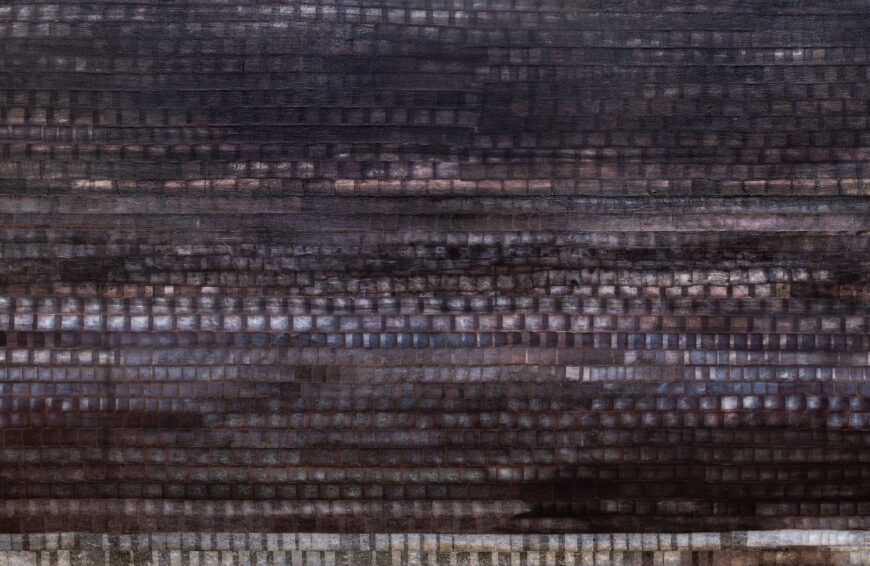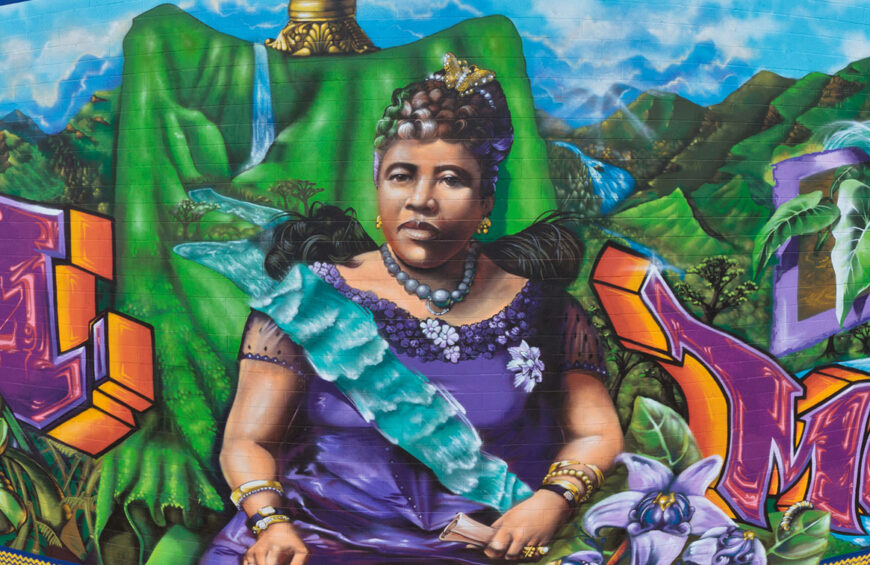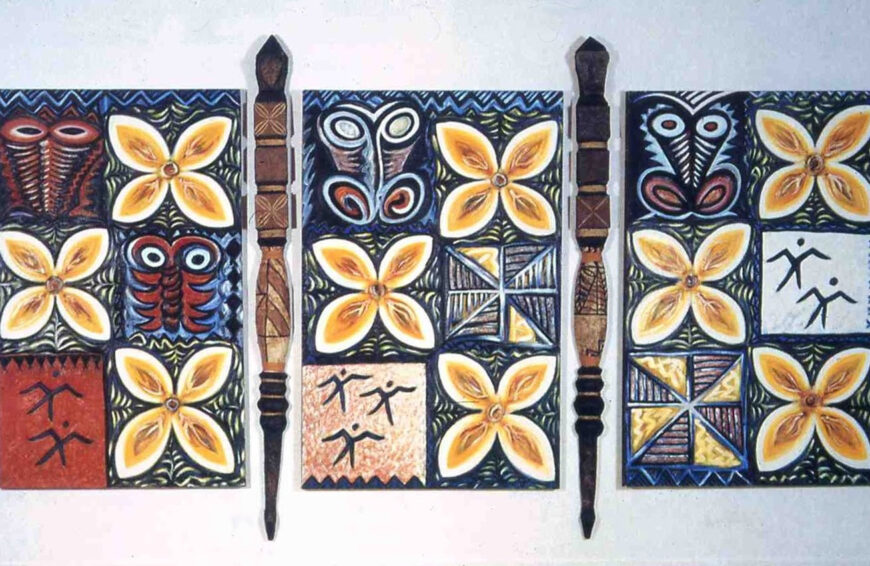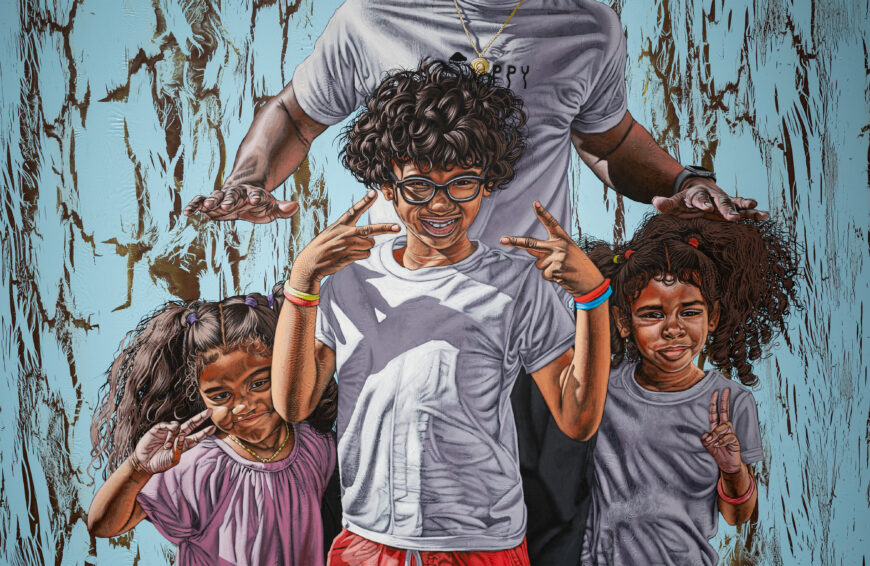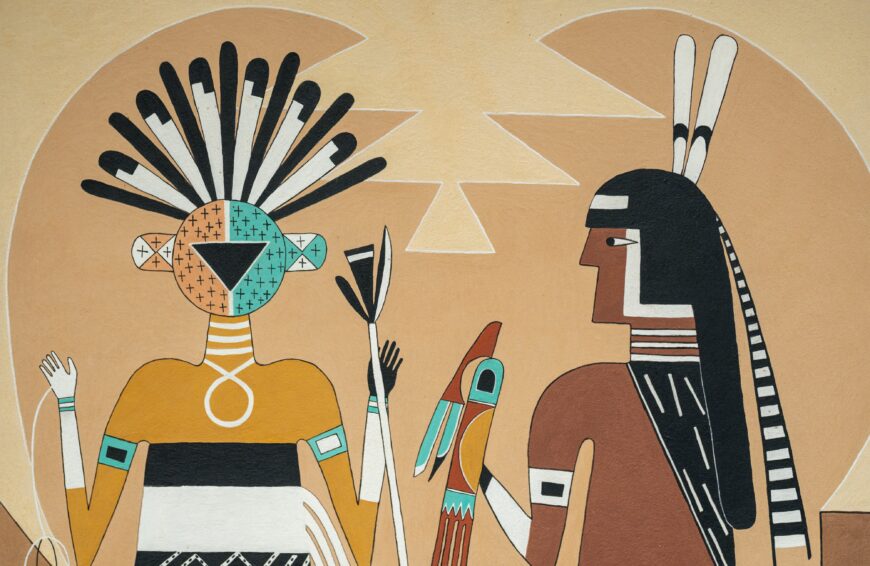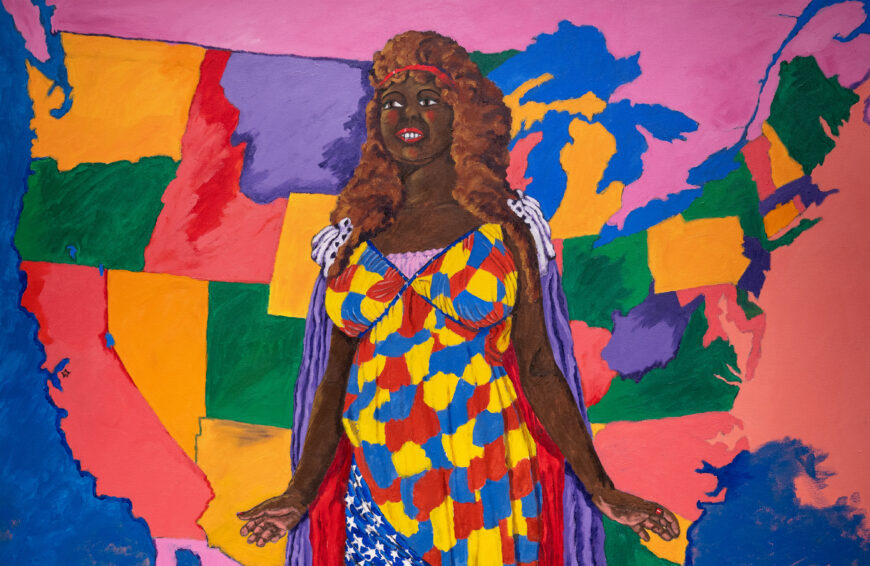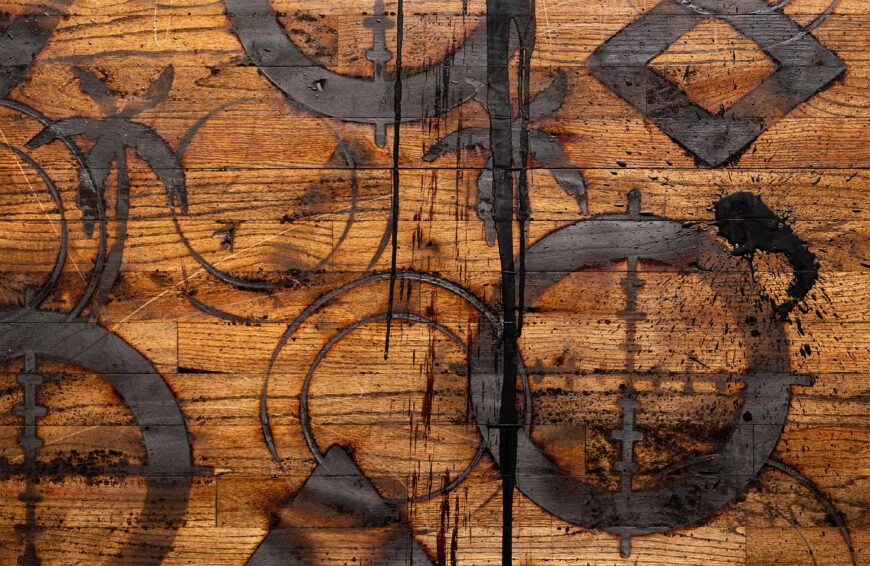
Gazellah Bruder, September, 2024, Vunairoto, Rabaul (photo: courtesy of the artist, CC BY-NC-SA 4.0)
Gazellah Bruder is a highly accomplished and internationally-known artist of Tolai and Mekeo ancestry who lives and works in Papua New Guinea (PNG). She is a painter, printmaker, sculptor, book illustrator, and textile artist, and has also worked in film and television. Her work focuses on social issues, gender, sexuality, and environmental change and she uses her art to promote dialogue about these critical issues.
Bruder is particularly concerned with women’s inequality and domestic violence in Papua New Guinea. Much of her art expresses her insights into women’s experiences and their journeys in life. Countering Euro-American stereotypical depictions of the people of Melanesia—a region of Oceania that extends from Papua New Guinea and West Papua to Fiji—that long represented them as “primitive,” exoticized or eroticized caricatures, or as anthropological “types,” Bruder’s representations of Papua New Guinea women capture their personalities, experiences, and resilience. Her work has received national recognition and in 2020 the PNG government selected her and four other artists to participate in the United Nations’ initiative to produce advocacy materials to prevent and respond to violence against women. [1]
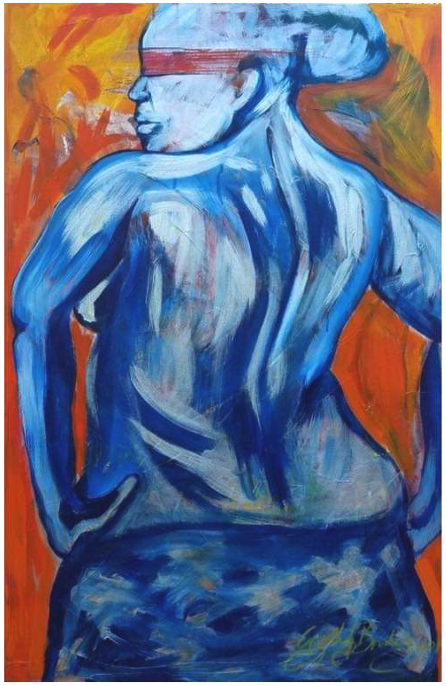
Gazellah Bruder, Goddess I Am, 2019, acrylic on canvas, approximately 90 x 60 cm (photo: courtesy of the artist, CC BY-NC-SA 4.0) © Gazellah Bruder
Goddess I Am
The previous year, in 2019, the Sir Brian Bell Foundation, a health and education organization in Papua New Guinea, awarded Bruder a Timothy Akis and Georgina Beier National Art Prize. This arts program aims to energize culture and heritage and recognizes the important role art plays in maintaining and preserving PNG traditions in dynamic ways. It promotes the arts as a form of communication and expression, a way of addressing trauma and challenging living conditions, and a means of furthering health and healing. Partnering with the “Grass Skirt Project,” which is dedicated to advancing gender equality, eliminating gender-based violence, and empowering girls and women through sports to cultivate strong and resilient communities, Bruder painted Goddess I Am as part of her work for the National Art Prize. [2]
Bruder presents an image of strength, decisiveness, and self-determination through the powerful body of a woman. Although her upper body is unclad and exposed, she is not the passive “dusky maiden” or exotic Melanesian “type” that appears in many Euro-American commercial and anthropological depictions of Oceanic women. She turns her back to our gaze, so as not to be objectified. Her hands are solidly placed on her hips in a stance of self-assuredness. The woman’s body occupies the full space of the painting, with her hair, legs, and right arm extending beyond the edges of the canvas as though to suggest that her presence is not contained or constrained.
Bruder uses color in an expressionist, rather than naturalistic, way. Various shades of blue accented with white, yellow, green, and red, executed in broad, energetic brush strokes, outline the body and define musculature and areas of softer flesh. Bruder’s palette contributes to interrupting the viewer’s expectation of seeing an eroticized body and instead focuses on the strength, substance, and beauty of the “goddess” portrayed. The artist describes the figure’s red blindfold as a “purely . . . subjective representation of ʻturning a blind eye’ and not focusing on what the world thinks of us.” [3] The painting is a demand for women to stand tall, value themselves, and take ownership of their own sense of self. Placed against a bright orange and yellow background that is activated by dynamic brush strokes and flashes of color, the woman stands out vividly in the forceful, energy-filled space she creates for herself and those around her. Goddess I Am “is about loving yourself, and not allowing the world to define or validate you. It is about embracing your womanhood and your sexuality. It is about embracing your every curve.” [4] The painting aptly served as the design for a women’s rugby team jersey as part of the Grass Skirt Project’s 2020 Hevea Cup and Wellness Expo. [5]
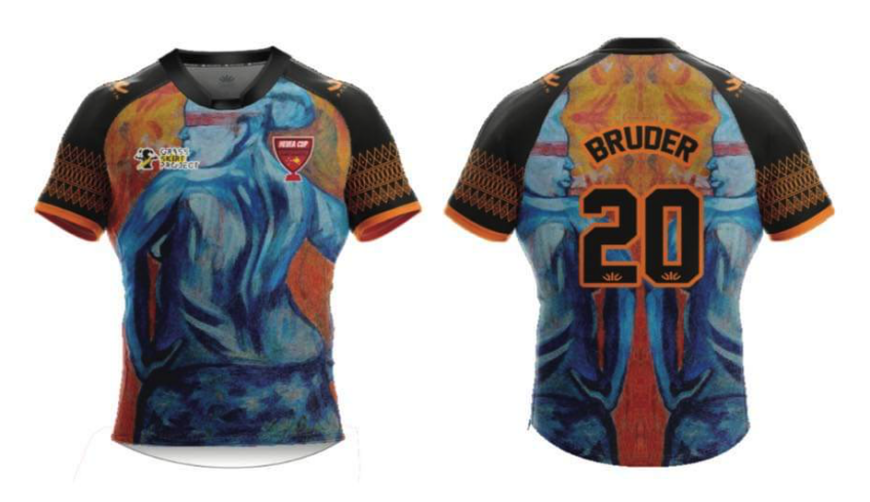
Gazellah Bruder, Goddess I Am as the design for a Grass Skirt Project women’s rugby team jersey, 2020 (photo: Grass Skirt Project, courtesy of the artist)
Feeding the Gods of Melanesia
In another painting by Bruder, Feeding the Gods of Melanesia, a woman stands amid lush foliage and holds a wooden bowl containing clusters of green bananas and stalks of taro root. Her presence is monumental; her figure fills and extends beyond the full vertical space of the painting, and the thick application of paint adds to her bodily substance. The woman’s stance is tall, stable, and strong, but not passive or stiff. The curves in her hair, arms, and body (accentuated by the slight arc in the design on the side of the dress) relay a dynamic posture that enlivens the figure and suggests active movement and agency in an otherwise somewhat still composition.
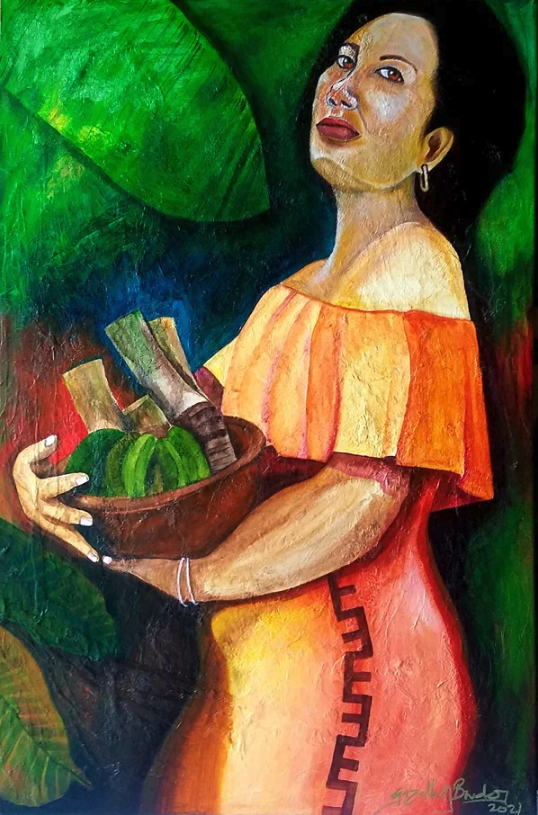
Gazellah Bruder, Feeding the Gods of Melanesia, 2021, mixed media on canvas, 90 x 60 cm (photo: courtesy of the artist, CC BY-NC-SA 4.0) © Gazellah Bruder
The bright yellows, oranges, and reds of her clothing emphasize the vibrance of her presence. Rather than a light from another source reflecting off her, the bright tones have the effect of making it seem as though the light emanates from her, illuminating her surroundings. And, although the woman stands out in front of the foliage, Bruder uses color to intimately connect her to the environment, whether the natural surroundings or the personal spaces of home and work. The bright and dark greens in the woman’s bowl echo the large leaves around her; the reds in her dress link to the red accents of color on both sides of her body; her skin tones resemble those of the banana and taro stems; and the rectilinear design in her dress is rendered in a similar color to the taro (and both the taro and the dress design share a similar curve). Overall, Bruder’s palette in this painting evokes brightness, life, and connection.
Describing this painting, Bruder states: “The visual idea of a wooden bowl filled with banana and taro takes you back to those simpler times when the Queen (mum) would prepare dinner. My mother made cooking a beautiful task, not tiresome and static. There was singing, stories and love, all infused with coconut milk.” [6] The viewer perceives a sense of the figure’s interiority; she gazes upward into the distance and offers a slight smile, as if occupied with her thoughts.
Empowering women through art
In Goddess I Am and Feeding the Gods of Melanesia, Gazellah Bruder presents portraits of strong women who are self-possessed, respected, and integral parts of their larger social and cultural communities. The artist states: “Appreciate yourself more than anyone else can. When you love yourself, you only invite what adds value to exist in your life. You empower yourself to rid your life of any form of toxicity.” [7] Bruder’s work aims to create empathetic relationships and further understanding between her, the figures in her artwork, and viewers.


